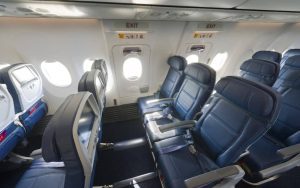Exit row seating on an airplane is often considered a prime spot for travelers seeking extra legroom and a quick exit in case of an emergency. However, these seats come with their own set of advantages and disadvantages that passengers should consider before selecting them. In this blog post, we’ll explore the pros and cons of exit row seating to help you make an informed decision for your next flight.
Pros of Exit Row Seating:
- Extra Legroom: One of the most significant advantages of exit row seating is the ample legroom it provides. These seats often have more space to stretch your legs, making long flights more comfortable, especially for tall passengers.
- Quick Exit: In the event of an emergency, passengers seated in the exit row are responsible for assisting the crew in opening the emergency exit doors. This means you’ll be among the first to exit the plane, potentially saving valuable minutes during evacuation.
- Priority Boarding: Many airlines offer priority boarding to passengers seated in the exit rows, allowing you to settle into your seat and stow your belongings before the cabin fills up.
- No Reclining Seats in Front: Exit row seats are usually in front of bulkhead seats or other non-reclining seats, so you won’t have to deal with the inconvenience of someone reclining into your space.
Cons of Exit Row Seating:
- Responsibility in Emergencies: While having a role in assisting with emergency exits can be a pro, it can also be a significant con. Passengers in exit rows must be physically capable of performing the required tasks, which may include lifting heavy doors. If you’re not up for this responsibility, exit row seating may not be suitable for you.
- Restrictions on Personal Items: Passengers seated in exit rows often have limited under-seat storage due to the proximity of emergency equipment. This means you may need to store your personal items in the overhead bins, which can be inconvenient during the flight.
- Potentially Colder Conditions: Exit row seats are sometimes located near emergency exits, which can be drafty and colder than other parts of the cabin. Dressing in layers or having a blanket handy can help mitigate this issue.
- No Young Children Allowed: Airlines typically restrict passengers traveling with infants, small children, or passengers requiring assistance from sitting in exit row seats. If you’re flying with young children, this option won’t be available to you.
- Limited Recline: Exit row seats may have limited or no recline due to the proximity of the exit doors. If you prefer to recline your seat for added comfort during the flight, this might not be the best choice for you.
In conclusion, exit row seating on an airplane offers valuable benefits, such as extra legroom and a quick exit in emergencies. However, it also comes with responsibilities and potential drawbacks, including restrictions on personal items and limited seat recline. Whether exit row seating is right for you depends on your personal preferences, physical capabilities, and the specific circumstances of your flight. Be sure to weigh these pros and cons carefully when making your seat selection to ensure a comfortable and safe journey.

